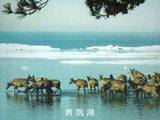 聯合國教科文組織(UNESCO)於20日將分屬18個國家的23個生態保護區,納入「人與生物圈(MAB)全球網絡」,其中薩爾瓦多、卡達、與阿拉伯聯合大公國都是該網絡的新成員。目前MAB網絡已擴及105個國家,共529個位址。
聯合國教科文組織(UNESCO)於20日將分屬18個國家的23個生態保護區,納入「人與生物圈(MAB)全球網絡」,其中薩爾瓦多、卡達、與阿拉伯聯合大公國都是該網絡的新成員。目前MAB網絡已擴及105個國家,共529個位址。
MAB網絡中的保護區並非嚴格的絕對保育區域,其設立重點是為探討並改善生物多樣性保育與人類社經發展的關係。這些保護區提供具體機會,讓科學知識得以和管理方式結合,在幫助減少生物多樣性損失的同時,也提高居民生活福祉,並促進符合環境永續的社經文化條件。
新增的23個保護區中,有四個位於亞洲:
越南藝安(Nghe An)省西部——
這片海拔超過2千公尺的山區,生態系包含低海拔季風常綠林與飄渺的雲霧林,生物多樣性極為豐富。本區對提昇傣族、土族、克穆、俄杜、苗族等少數民族的生活水準有重要價值。
蒙古國蒙古達哥(Mongol Daguur)——
鄰近中蘇蒙邊界,擁有平原、緩丘與濕地的溫帶草原生態系。許多遷徙於西伯利亞與南太平洋間的候鳥在此築巢繁殖。
中國車八嶺——
擁有亞熱帶常綠闊葉林,瀕臨絕種的華南虎(Panthera tigris),與最近重新發現的珍稀水鳥海南鳽(Gorsachius magnificus)都棲息於此。目前當地正發展生態觀光。
中國興凱湖——
東亞最大的淡水湖,匯集了湖泊、沼澤、平原與丘陵等內陸濕地生態系,擁有豐富的魚類與鳥類生態。當地居民以漁撈、造紙與種稻為生,旅遊業也日益蓬勃。
世界其他地區新增的保護區則分別位於阿拉伯聯合大公國、黎巴嫩、卡達、葡萄亞、西班牙、加拿大、墨西哥、薩爾瓦多、哥斯大黎加、厄瓜多、阿根廷、智利、南非、澳洲、以及密克羅尼西亞。
「人與生物圈全球網絡」529個保護區的完整名單與介紹,可參考 http://www.unesco.org/mab/BRs/BRlist.shtml
The first biosphere reserves set aside by El Salvador, Qatar, and the United Arab Emirates are among 23 new reserve sites in 18 countries today accepted by UNESCO into its Man and the Biosphere global network. The network now extends to 529 sites in 105 countries.
The reserves are not strictly protected areas. Emphasis is placed on linkages between biodiversity conservation and socio-economic development. Opportunities are developed to combine scientific knowledge and governance to reduce biodiversity loss; improve livelihoods; and enhance social, economic and cultural conditions for environmental sustainability.
The new biosphere reserves in Asia are:
Western Nghe An, Vietnam. Due to the mountainous terrain reaching an altitude of over 2,000 meters, the area has a high level of biodiversity ranging from lowland monsoonal evergreen forests to elfin cloud forest. This site could play an important role in raising the standard of living of ethnic groups such as the Thai, Dan Lai, Kho Mu, O Du, and H'Mong.
Mongol Daguur, Mongolia near the borders of Russia and Chinese-Mongolia is temperate grassland ecosystem with plains, rolling hills and wetlands. It is a nesting and breeding ground for migratory birds along the Northeast Siberia - South Pacific migration corridor.
Chebaling, China, in the south of the country, contains sub-tropical evergreen broad-leaved forests. It is home to the endangered Chinese tiger, Panthera tigris, and the recently rediscovered white-eared night heron, Gorsachius magnificus. Ecotourism is being developed.
Xingkai Lake, China includes the Chinese part of the largest freshwater lake in Eastern Asia. This mosaic of inland wetland ecosystems with lakes, swamps, plains, and hills supports a high diversity of fish and bird species. The local population relies on fishing, paper and rice production, Tourism is growing here.
Others are:
Marawah Biosphere Reserve, United Arab Emirates.
Jabal Al Rihane, Lebanon
Al-Reem, Qatar
Corvo Island, Portugal
Graciosa Island, Portugal,
Rio Eo, Oscos y Terras de Buron, Spain
Manicouagan Uapishka, Canada
Fundy, Canada
Sierra de Alamos - Río Cuchujaqui, Mexico
Apaneca-Llamatepec, El Salvador
Xiriualtique Jiquitizco, El Salvador
Agua y Paz, Costa Rica
Podocarpus-El Condor, Ecuador
Andino Norpatagonica, Argentina
Pereyra Iraola, Argentina
Bosques Templados Lluviosos de los Andes Australes, Chile
Cape Winelands, South Africa
Noosa, Australia
And Atoll, Federated States of Micronesia
(Visit http://www.unesco.org/mab/BRs/BRlist.shtml for a complete list of 529 UNESCO Biosphere Reserves)




